Recent Storm Damage Posts
Hurricane Season Is Here – Steps to Prevent Water Damage and Protect Your Property | SERVPRO® of East Mecklenburg/Matthews
9/20/2024 (Permalink)
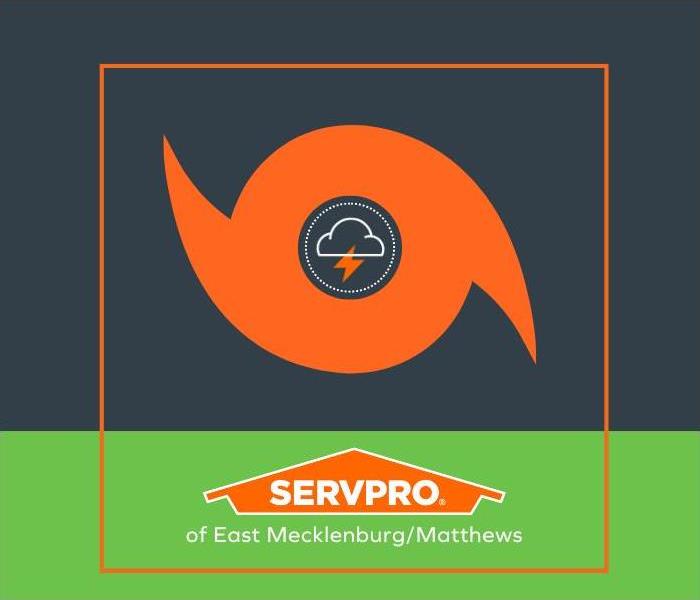 Quick and efficient hurricane response from SERVPRO of East Mecklenburg/Matthews helps minimize damage and restore your property faster.
Quick and efficient hurricane response from SERVPRO of East Mecklenburg/Matthews helps minimize damage and restore your property faster.
Hurricane rainfall presents an opportunity for water damage to your Matthews, NC property. Leaks and floods can cause significant harm and may require you to temporarily vacate your building while it's being restored. This creates a challenge, as you’ll want to get back to business as usual as soon as possible! Furthermore, severe leaks can lead to floods, increasing the risk of exposure to mold, chemical hazards, injuries, and more.
Fortunately, these inconveniences are preventable! Whether your water emergency occurs in an office building or a big box store, it’s imperative to take proactive measures to prevent leaks and damage to your property. Keep an eye out for the following:
Damaged Windows
Water can seep through windows that aren’t properly sealed, leading to mold buildup and wall damage. Since caulk—the material often used to seal windows—breaks down over time, be sure to have your windows resealed regularly.
Broken Pipes
Changes in pressure throughout the year, along with cold weather, can cause pipes to break or burst. Although there are some telltale signs of this issue, such as water stains on walls or floors or a musty smell, detecting leaky pipes can be challenging. It's best to consult a professional to determine if your property has broken pipes.
HVAC Problems
During hurricane season, colder temperatures may lead us to turn up the heat. However, ducts in the HVAC system can wear out and become damaged over time, especially during extreme weather, causing leaks. Therefore, it’s essential to clean the system regularly and remove any accumulated water. As with broken pipes, identifying leaks from an HVAC system can be difficult, so consulting a professional is recommended.
September is one of the rainiest months in Charlotte, NC, and across the Southeast. With this in mind, it’s important to stay ahead of potential water damage issues.
One of the best ways to prepare is by creating a SERVPRO® Emergency Ready Profile. This immediate plan of action outlines how to restore your building after a disaster and resume business operations quickly. Additionally, we utilize 360-degree technology to document preloss conditions, including your equipment and its placement before the disaster struck.
If you want to prepare your business for future disasters, contact SERVPRO of East Mecklenburg/Matthews today, and we’ll help you create an Emergency Ready Plan.
Consider Doing a Post-Storm Damage Check for Your Home | SERVPRO® of East Mecklenburg/Matthews
9/19/2023 (Permalink)
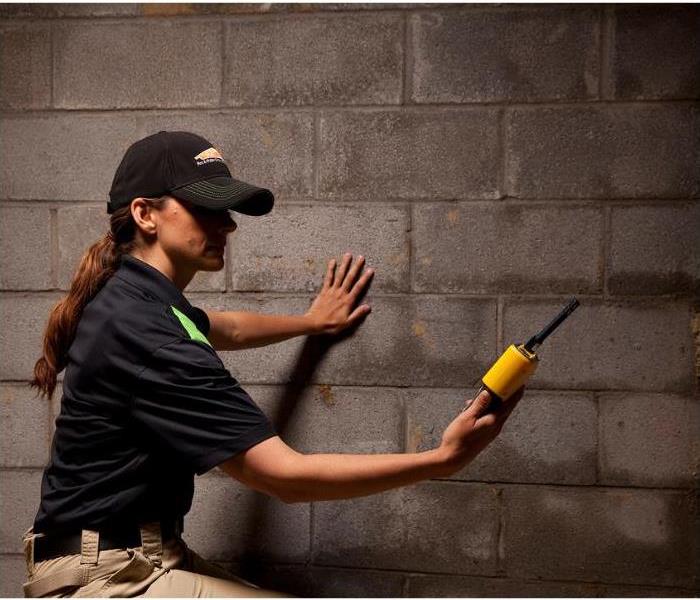 If you have pooled water around your foundation or find moisture in your home, SERVPRO® of East Mecklenburg/Matthew is here to help.
If you have pooled water around your foundation or find moisture in your home, SERVPRO® of East Mecklenburg/Matthew is here to help.
Storm damage can be highly unpredictable. Even if a storm does not feel severe or frightening, damage to your home remains a genuine possibility after every severe weather incident. With high winds, hail and heavy rains, there are many ways that storm damage can occur all around your home.
In every case, catching this damage early on is your best bet for remedying it without too much hassle or headache. Damages can quickly compound and give rise to secondary issues if left unnoticed, so catching it early is critical. Fortunately, by doing a post-storm damage inspection after every storm, you will be far more likely to catch these problems quickly so that you can call us.
2 Things to Check on Your Home After a Storm
Check for Any Pooled Water Around the Foundation
Moisture is the No. 1 enemy of the longevity of any home, but just because you do not have any visible leaks does not mean you are in the clear. As soon as possible after a storm subsides, check around your foundation for any spots of pooling water.
This may indicate that you do not have adequate drainage around your home, and over time, this can lead to moisture seeping into the foundation and causing issues. If you do not have damage yet, installing more drainage pathways can often remedy the problem quickly.
Do a Visual Examination of Your Roof
Of course, climbing on your roof after every storm would not be practical (or safe), but doing a from-the-ground inspection can give you a good idea of if you need to call in a professional—you can even use binoculars to get a better look.
Missing shingles or areas where they appear loose are a clear sign that you should get an expert’s opinion and potentially have the roof patched. The roof is your first line of defense against any type of moisture getting into your home, and can quickly lead to severe leaks or other issues if not addressed.
If your home has been damaged due to a storm, you can depend on SERVPRO® of East Mecklenburg/Matthews to take care of it. Our trained restoration technicians are here 24/7 to help you out. Get in touch today so we can come take a look.
What to Do if a Thunderstorm Catches You Outside | SERVPRO® of East Mecklenburg/Matthews
9/9/2022 (Permalink)
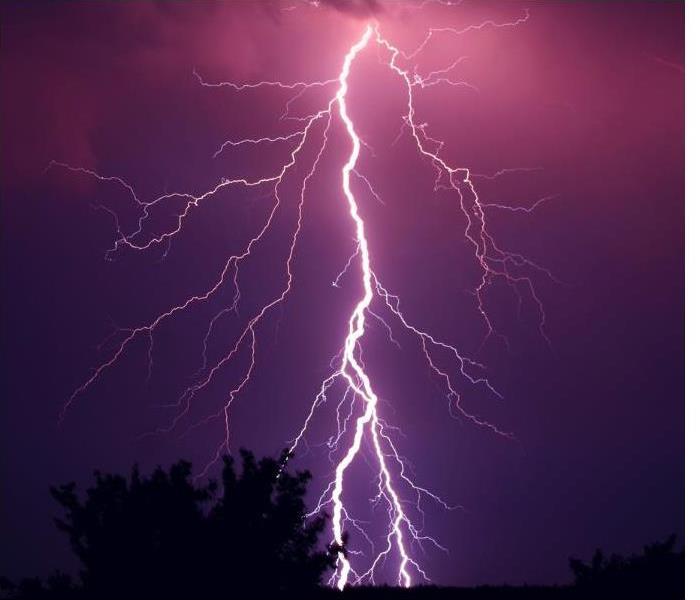 Lightning commonly strikes the tallest object in the area.
Lightning commonly strikes the tallest object in the area.
Thunderstorms can be frightening no matter where they occur, but if one catches you while you are outside and away from a shelter, it can be terrifying to endure. While checking weather alerts is always a wise thing to do before heading out, storms tend to pop up suddenly this time of year as they thrive off the heat and humidity.
While being in a building during a thunderstorm is the safest option (with being in your vehicle a close second), knowing what to do next is vital if you are away from buildings and cars when a storm strikes.
How to Seek Shelter From a Storm if You Are Outdoors
Get to low ground. Lightning takes the most direct route to get to the ground, which is why it commonly strikes the tallest object in the vicinity. While this is not absolute, getting low to the ground reduces your chances of being hit. Avoid hills or wide-open spaces, and try to crouch in a less exposed area if possible.
Avoid being near tall objects. Being extremely close to an object struck by lightning is almost as dangerous as being hit yourself, so avoid tall objects when possible. Trees, light poles, flagpoles, and even fences are more likely to attract lightning, so avoid them if possible to not be a target yourself.
Get away from water. Water is an excellent conductor of electricity, so if lightning strikes a body of water, everyone nearby is in danger. If you are swimming, get out of the water as soon as the first clap of thunder sounds, which signals that lightning is nearby. If you are on a boat and can not get to shore before the storm begins, drop your anchor and crouch down in the boat, or go into the cabin if your boat has one on board. Avoid touching any metallic surfaces in the boat, as well.
If a storm damages your home or business, you can count on SERVPRO® of East Mecklenburg/Matthews to help. We are here 24/7, so you can report your damage and get a rapid response. Contact us today to learn more.
Steps You Should Take As Soon As the Storm Has Passed | SERVPRO® of East Mecklenburg/Matthews
7/14/2022 (Permalink)
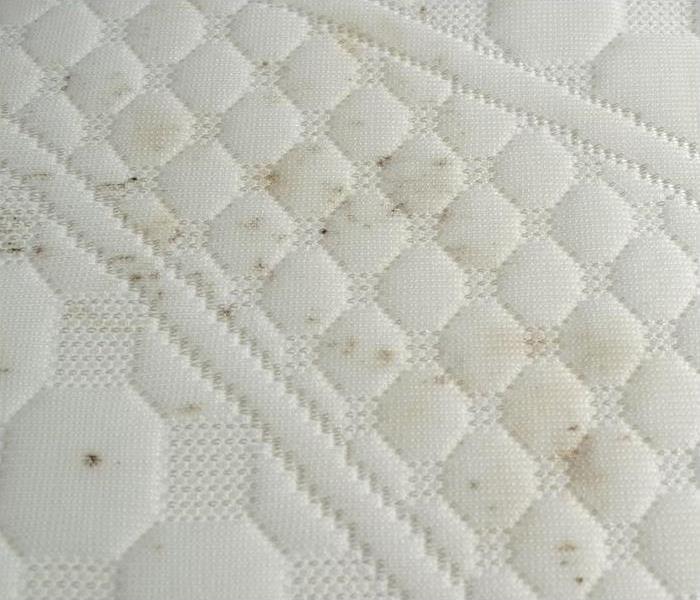 After a storm, make sure you document any damage to your property. Then make sure you reach out to SERVPRO® of East Mecklenburg/Matthews.
After a storm, make sure you document any damage to your property. Then make sure you reach out to SERVPRO® of East Mecklenburg/Matthews.
Storm damage can occur at any time and can cause an extreme level of destruction to your beloved home. Heavy rains can cause flooding, and powerful winds can rip off parts of your roof. Powerful storms also have the potential to pull trees out of the ground and topple them onto your home.
Some post-storm damage that occurs can also cause safety or health hazards, so having a strategy to deal with the damage immediately is the best way to stay safe.
Beyond having a strategy to handle the aftermath, it’s important for you to determine the most common risks we see here in Mecklenburg County so that you can plan accordingly. We see approximately 20% more precipitation than the national average, which means that water damage is going to be a secondary factor when it comes to storms.
You can plan accordingly for the disasters we experience most and utilize special landscaping techniques that direct water away from the home. You could also replace the seals around your doors and windows, and inspect your roof for leaks to make sure you can outlast the next storm.
Take Safety PrecautionsHeavy winds and rain have the potential to create physical hazards like collapsed roofing pieces, window damage and standing water inside the home’s interior. When inspecting your home for damage, be wary of broken glass, exposed nails, or other sharp and potentially dangerous objects around the property.
Additionally, moisture can soak into the furniture, carpet and wood, which creates the perfect environment for mold to begin growing. Mold has been shown to cause serious health complications, especially for those who have pre-existing conditions like asthma.
If necessary, you may need to find alternative places for you and your family to stay while our experts are restoring your property back to its preloss condition.
Document Potential DamageOnce you have determined that it’s safe to move around your property, it’s important to perform a walkthrough and inspect the home for damage. While checking every area of your home, it’s crucial that you document any damage that has taken place as a result of the storm.
You can use your cellphone camera to photograph and record videos of the damage so that you have an immediate record for your insurance company.
Contact Your Insurance CompanyOnce you have performed a walkthrough and have a good understanding of the level of damage, contact your insurance agent. The company will then send out an adjuster to collect your evidence and determine the extent so that you can be reimbursed for any repair costs associated.
Call the ProfessionalsAfter inspecting your home for damage, documenting it thoroughly and calling your insurance provider, you should call SERVPRO of East Mecklenburg/Matthews. Our restoration professionals come with industry-leading equipment that can repair almost any destruction.
We’re proud to say that we offer 24⁄7 availability so that we can be there right when you need us most. Don’t hesitate to begin your restoration process—call us today!
Experienced storm damage to your home or property? Contact us today for a quick response!
Is Lightning Really Dangerous?
7/7/2022 (Permalink)
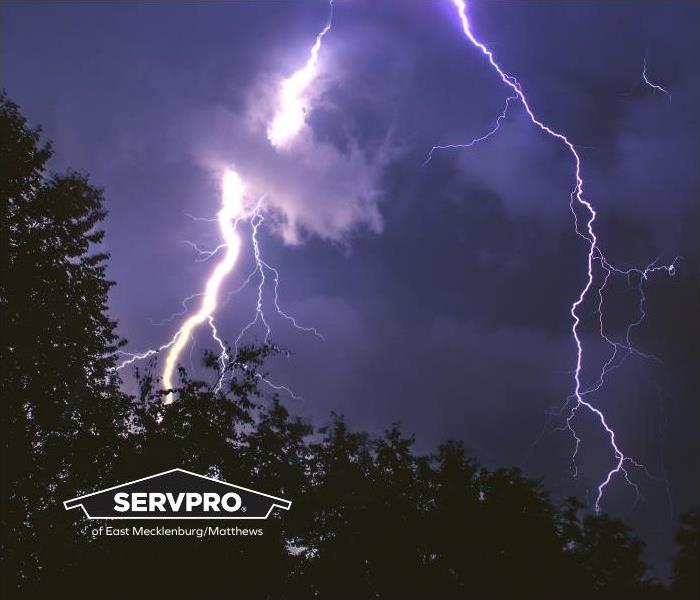 How dangerous is lightning really?
How dangerous is lightning really?
During a storm, there are many factors that have the potential to cause serious damage to your house. Besides wind, rain, and falling trees - one big one …
Lightning!
You may have heard the phrase lightning never strikes the same place twice. However this statement isn’t always true, it often strikes in the same place if there is a tall pointed object. The Empire State Building has been said to be struck an average of 25 times a year!
Some people also believe that lightning is only dangerous during cloudy or rainy conditions, the truth is, it can reach more than three miles outside of a storm. Lightning has even traveled as far as 15 miles before it strikes the ground. Even if the storm is a few miles away, it is smart to seek shelter and prepare for the coming storm.
Lightning is more than a loud noise during a storm, and a lightning strike to your Matthews, NC home, or business can cause fire and other serious damage. So what happens when lightning strikes your home?
- Shock Waves: When lightning strikes your home, it can send a shock through the walls. Lightning can leave cracks in the walls, brick, stone, concrete, and your fireplace. In some cases, there may even be cracks in your foundation after a lightning strike.
- Power Surges: One of the most commonly talked about damages caused by lightning is power surges. When lightning strikes your home it sends a large amount of power through the wiring in your home, often blowing fuses and causing damage to electronics. That power surge could cause a fault somewhere and start a fire right away, or later.
- Fire Damage: Not only can a fire start from wiring damaged during a surge, but it can also start from the lightning coming into contact with flammable objects. Your home is made from flammable objects like wood which can ignite when lightning travels through it.
So what does the damage to your home look like after a lightning strike? Your home could be completely fine with no damage at all, but not every situation is so lucky. Fires can start and spread in a matter of moments after the lightning strike. When the Matthews Fire & EMS come to help put out the fire you could be left with even more damage from the water.
If your home or business is struck by lightning and is left with fire or water damage make sure to call SERVPRO of East Mecklenburg/Matthews.
What Actions Should You Take After a Major Storm? | SERVPRO® of East Mecklenburg/Matthews
5/19/2022 (Permalink)
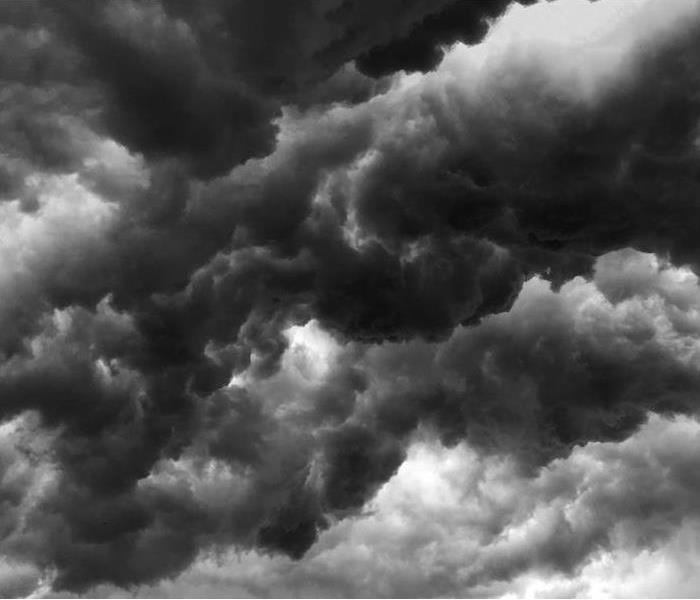 In the unfortunate event that your home has sustained damage, you can count on SERVPRO® of East Mecklenburg/Matthews to help.
In the unfortunate event that your home has sustained damage, you can count on SERVPRO® of East Mecklenburg/Matthews to help.
While it’s always important to prepare yourself and your home before a storm arrives, that option sometimes gets forgotten or neglected, so knowing what to do afterward is crucial. A lot of homeowners feel helpless after a natural disaster, but you can avoid that by having a good plan.
In North Carolina, we are no strangers to extreme weather. Between hurricanes, thunderstorms, flooding and the occasional snowstorm, we see our fair share of disasters around here. However, extreme weather is putting people all over our region at risk, with over 30 million people at risk of storms every day across the southeastern United States.
The procedure of handling storm aftermath will depend primarily on if you were forced to evacuate or if you sheltered in place. Regardless of your specific situation, here are some basic steps to take after you face extreme storms.
Take Proper Safety PrecautionsIf you are back at your home after the storm, it’s important to check with local authorities and news for updates around your area.
Those resources will help you identify any dangers that you may face if you have to travel or leave the property. This would include things like fallen trees or power lines, washed-out roads, flooding, and extensive debris that may be strewn about the city.
Additionally, if your home itself has suffered damage, be extremely cautious when maneuvering around inside or moving things around. The structural integrity of your house could be compromised, and if so, could put you at risk of personal injury.
Also, be aware of any damaged trees around your land, which often take significant damage during storms and can fall over hours or days after it has passed.
Attempt to Rescue What You CanAs long as your home is safe to move around in, it’s a good idea to collect any personal items that are savable. For example, when homes sustain heavy flooding, any item that can be damaged from contact with water should be moved to a higher location, or out of the home altogether.
Don’t waste all of your energy trying to move every single item though, assessing the totality of the damage during this step is also important. Take photographs with your cellphone for later, and write down the estimated cost of any items you notice are substantially damaged.
Many people believe that flooding is exclusive to the coasts, but there are more than 450,000 at risk of flooding in the inland part of North Carolina alone. Don’t underestimate your risk of damage, and be sure to pay attention to your local emergency alerts when storms are coming.
Check Your Water QualityWithout receiving the go-ahead from your local government, it’s highly risky to drink from your home’s water. Many times during storms, cities’ water supply will be compromised from storm damage, and can even contain sewage with enough destruction to the pipelines.
When you do leave your home, be sure to buy nonperishable foods and plenty of bottled water until you’re sure that the water at home is safe.
Call the ExpertsIn the unfortunate event that your home has sustained damage, it’s critical to act immediately to get the best results. By choosing SERVPRO of East Mecklenburg/Matthews, you’ll be guaranteed a quick response time, allowing us to get you back in your home as quickly as possible.
If you discover storm damage to your home or business, you can count on SERVPRO to handle the restoration. We’re here 24⁄7 to spring into action—get in touch with us today.
How Cleaning Your Gutters Can Help Prevent Storm Damage | SERVPRO® of East Mecklenburg/Matthews
5/16/2022 (Permalink)
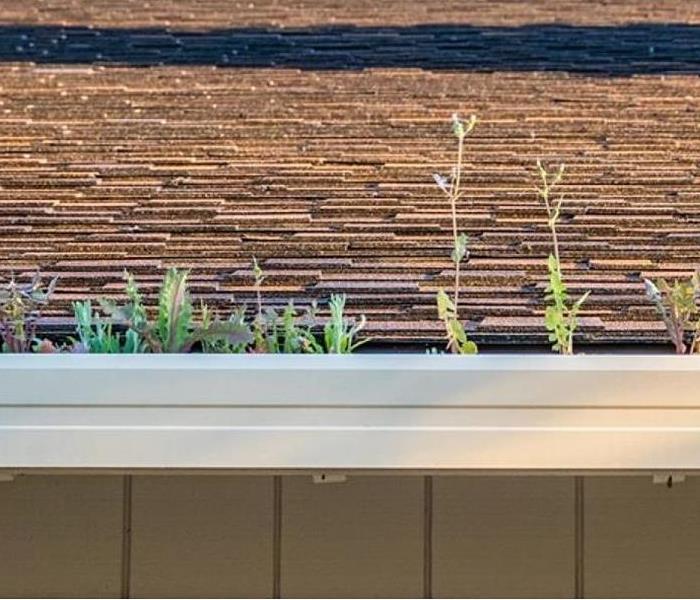 Storm damage can occur when you least expect it. SERVPRO® of East Mecklenburg/Matthews is available 24/7 to assist you with any repairs.
Storm damage can occur when you least expect it. SERVPRO® of East Mecklenburg/Matthews is available 24/7 to assist you with any repairs.
Spring has sprung, and the time for spring-cleaning is here! Yes, we know—it’s something many homeowners don’t look forward to.
But we aren’t here to talk about dusting your living room or deep-cleaning the curtains. Instead, we’d like to talk about a way that you can do some spring-cleaning and home maintenance all at once.
That’s right, you can kill two birds with one stone. In fact, with this particular spring-cleaning to-do, you can actually knock out three birds! We’re talking about cleaning the gutters.
By taking some time to clean the gutters this spring, you’ll not only improve the appearance of your home, but you’ll also help protect it from wear and tear and may even prevent storm damage.
What to Know About the Gutters
You might not think about your gutters much. But when it comes to storms, the gutters can be one of your home’s biggest defense mechanisms.
That’s because gutters are designed to take rain and storm water off the roof and away from the structure of the house. Even if there’s only a trickle of rainfall (not the downpours we’re accustomed to here in the Charlotte area), as the rain falls onto the roof, it merges together and can create a surge.
This surge of water can have disastrous consequences for your roof and for the structure of the house, planting (and leaving) water in places it doesn’t need to be.
Gutters take that water and redistribute it, carrying it out into the yard and away from the house foundation.
Why You Need to Clean the Gutters
If you never clean out your gutters (or rarely do, anyhow), you’re setting your house and property up for damage. You may not notice the effects of clogged gutters when it’s only lightly sprinkling, but when we’re under a flood watch or when a storm occurs, that gutter clutter can wreak havoc.
As leaves, sticks and other debris get trapped in the gutters, it narrows the path for water to travel to escape from the roof. Over time, it can entirely cut off the flow of water, causing that water to sit where it is—resulting in roof leaks, other roof damage and structural damage as the water seeps down in the soil along the home’s foundation.
That’s an insidious kind of storm damage, one that you have the power to stop before it starts! Regularly clearing out the gutters can help give even excessive rainfall a safe passage down to the ground, protecting your home and your possessions.
Despite our best precautions, sometimes storm damage still strikes. If your home was damaged by a storm, we’re here to help make it “Like it never even happened.”
Potential Hazards After a Disaster | SERVPRO® of East Mecklenburg/Matthews
3/7/2022 (Permalink)
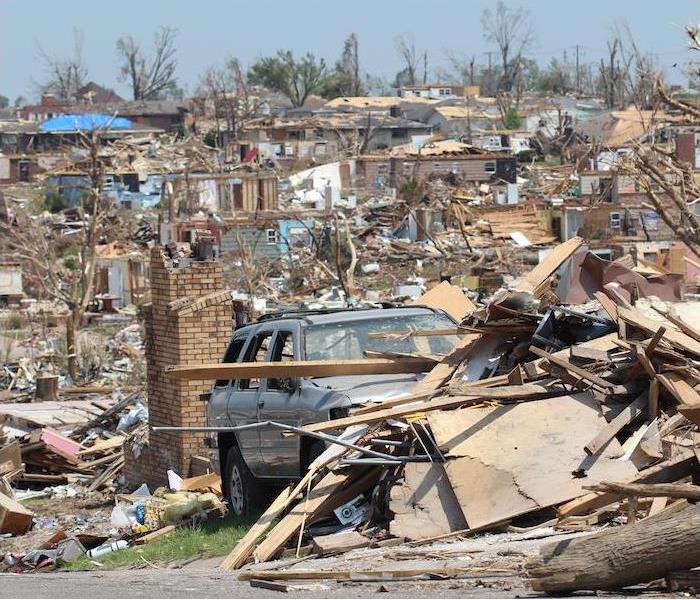 When it comes to disaster relief, SERVPRO of East Mecklenburg/Matthews are your local restoration experts.
When it comes to disaster relief, SERVPRO of East Mecklenburg/Matthews are your local restoration experts.
Taking the first look around your damaged home after a disaster such as a tornado or windstorm can be shocking. It may be wildly overwhelming to even know where to begin, on top of the emotional toll of experiencing something as devastating as these types of storms can be.
Tornadoes and other severe storms can rip through buildings, causing power outages, exposing electrical wiring and destroying structurally essential walls. It’s important to know what to do after a storm so that you do not expose yourself to dangerous hazards that can arise after the storm passes.
Let’s look at a few of these potential hazards:
Gas Leaks. As you may know, many buildings and homes have gas lines that power heat and/or electricity. When a storm hits, it can damage gas lines causing invisible leaks. If you smell gas or even suspect there could be a leak, call a professional to inspect the property before turning on any lights, smoking or anything at all that might cause a spark, leading to an explosion from the gas leak.
Carbon Dioxide Poisoning. Oftentimes, severe storms will cause power outages, leading to the use of alternative sources of fuel or electricity for heating or cooking like gasoline-powered generators. It’s vitally important that you do not use these inside your home or garage, but to keep them outdoors, as a deadly gas called carbon monoxide is released and can build up if used indoors and poison the people and animals.
Electrical Shock Hazards. If the storm has caused flooding in the home, it’s very important to call an electrician to asses the property for safety. Do not enter a home with standing water, especially if you are unsure if the electrical circuits in the home have been cut off. It’s very important not to turn on any appliances or touch any electrical items plugged into the walls if you are standing in water.
When it comes to disaster relief, SERVPRO of East Mecklenburg/Matthews is the expert. If you have any questions at all about the safety of the property, it is not worth the risk. Call our experts today and we will safely, properly and quickly get to work assessing the damage and restoring your property.
That’s Not Hail, It’s…Graupel? | SERVPRO® of East Mecklenburg/Matthews
11/22/2021 (Permalink)
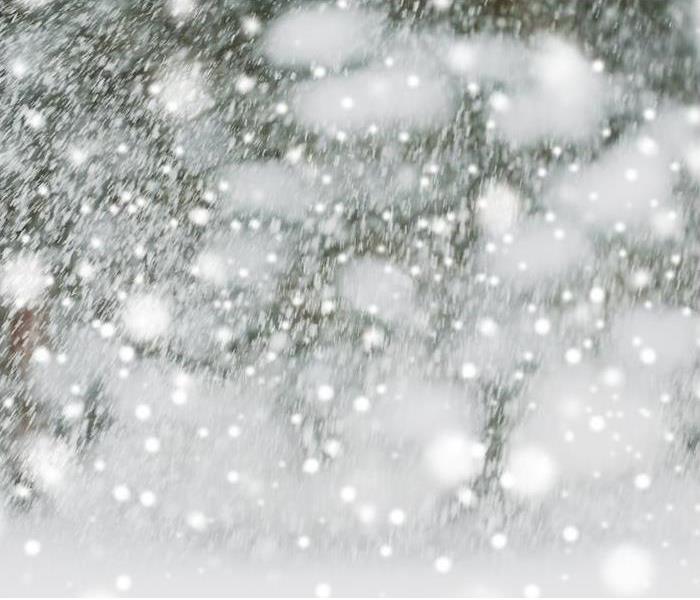 If storms or precipitation cause damage to your home or business, contact SERVPRO of East Mecklenburg/Matthews.
If storms or precipitation cause damage to your home or business, contact SERVPRO of East Mecklenburg/Matthews.
There are many forms of precipitation, and we’re likely to see them all over the course of a Matthews winter—all but one, that is.
Have you ever noticed that it doesn’t hail in winter, or thought about why it doesn’t hail in winter? Of course you have; you’re very inquisitive, and that’s why we love you.
So we’re going to make your day today, by helping you differentiate the different types of precipitation you’re likely to experience over the next few months in Mecklenburg County, including one that sometimes masquerades as hail.
Rain. If you’re not able to define this one by now, we need to start over. Rain forms when water vapor condenses as part of the global water cycle, which consists of condensation, precipitation and evaporation. The drops get too heavy to be held in the clouds, and they fall to the earth in the form of raindrops.
Freezing rain. Freezing rain appears to us to be rain that freezes once it hits the ground, but it’s actually melted snow that refreezes when it hits the ground. Snow crystals descending from clouds encounter warmer, moist air and melt. When they hit the cold ground, they freeze again and create a thin layer of ice if enough drops fall.
Sleet. Sleet has the same origin story as freezing rain, in that it begins as a snowflake and descends through a moist, warm layer of air. But thinner layers of moist air cause snowflakes to melt incompletely, and they becomes small ice pellets instead of raindrops. These pellets are what we know as sleet, and they, too, form a potentially dangerous layer of ice when they hit the ground.
Graupel. Sometimes called soft hail, corn snow, snow pellets, this frozen precipitation is rarely mentioned, but often mistaken for hail. It forms when very cold water droplets come in contact with falling snowflakes and combine into tiny balls of ice that vary in size up to about 0.2 inches—this process is called riming and it creates a unique precipitation that is hard enough to be ice, but soft enough that it typically disintegrates when touched.
Graupel pellets never reach a size that could classify them as hailstones, and their formation is different. Hail forms because of low pressure rising from the earth’s surface, which doesn’t happen in winter.
So now you know—you may see several kinds of frozen or freezing precipitation this winter, but hail won’t be one of them. Regardless of what type you encounter, be sure to be very cautious if driving or walking during a winter weather event, especially if weather becomes severe.
If storms or precipitation cause damage do your home or business in East Mecklenburg County, you’ve got a team nearby who’s ready to help. Contact SERVPRO today to see how we can assist you.
How Do Thunderstorms Form? | SERVPRO® of East Mecklenburg/Matthews
9/17/2021 (Permalink)
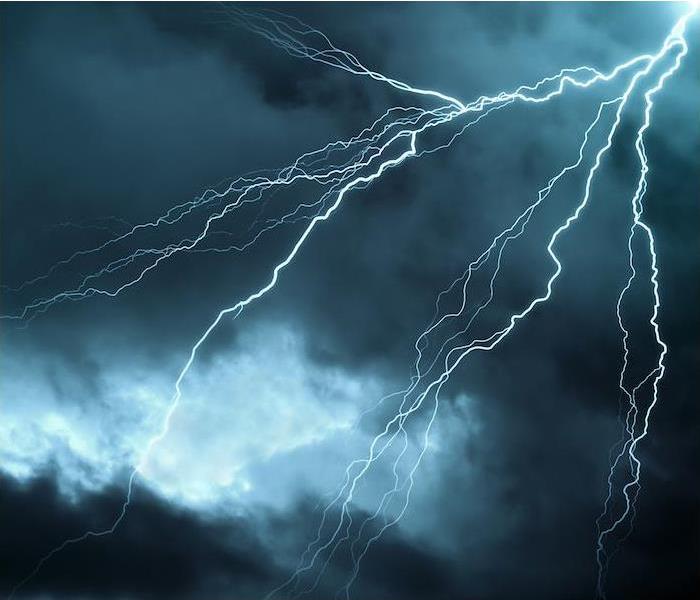 If thunderstorms should bring water or damage to your home or business, SERVPRO of East Mecklenburg/Matthews is your local expert in restoration
If thunderstorms should bring water or damage to your home or business, SERVPRO of East Mecklenburg/Matthews is your local expert in restoration
We experience thunderstorms regularly in the greater Charlotte area, and we know that they are a common (sometimes all too common) weather event. We might even look up into the sky or notice a drop in temperature and become aware of the impending possibility of a storm.
We often focus on the result of storms—flooding, heavy rains and water damage—but have you ever thought about what’s going in the atmosphere to actually cause one of nature’s most common weather exceptions? What are the atmospheric pieces that have to be in place to cause one?
Without getting too deep in the science, let’s take a look at the formation of thunderstorms.
How Storms Form
Ordinary thunderstorms, also called single cell storms, form when moist, warm air just above the earth’s surface rises into cold air in the atmosphere above. This causes the warm, rising air to cool, and when it does the moisture (or vapor) already present in the water condenses (shrinks and gathers in the air) and forms small water droplets.
The heavier cool air then lowers into the lower atmosphere, where it warms, rises, condenses and falls again. This continues to happen in a repetitive cycle called a convection cell, which eventually becomes a cloud.
When larger amounts of air and moisture collide, a larger convection cell can form and create a thunderstorm.
3 Stages of a Storm
Most storms form in a pattern of three stages:
The Cumulus Stage, described above as the formation of the formation of the convection cell. The warm air meets the cold air, and condensation begins.
The Mature Stage, where the cloud turns grey as more moisture condenses, and the condensed droplets become too heavy to rise anymore. They begin to fall, and we have ourselves a thunderstorm. The air moving within the clouds here also builds up an electric charge, and this (in a very simplified way) is why we get lightning.
The Dissipating Stage, in which cool, dry air that has been pulling rain down toward the ground (aka a downdraft) becomes stronger than the updraft of warm air, stopping the ability of droplets to form in the cloud. The cloud disappears from the bottom up, the sky clears and the storm is over.
There are lots more interesting details and several different types of storms, but we’ll let you search those out on your own for now. For now, remember:
*If thunderstorms should bring water or lightning damage to your home or business, SERVPRO is your expert friend in the restoration industry. Let us help you when disaster strikes.�*
The Physical and Financial Impact of Water Damage From Hurricanes | SERVPRO® of East Mecklenburg/Matthews
5/19/2021 (Permalink)
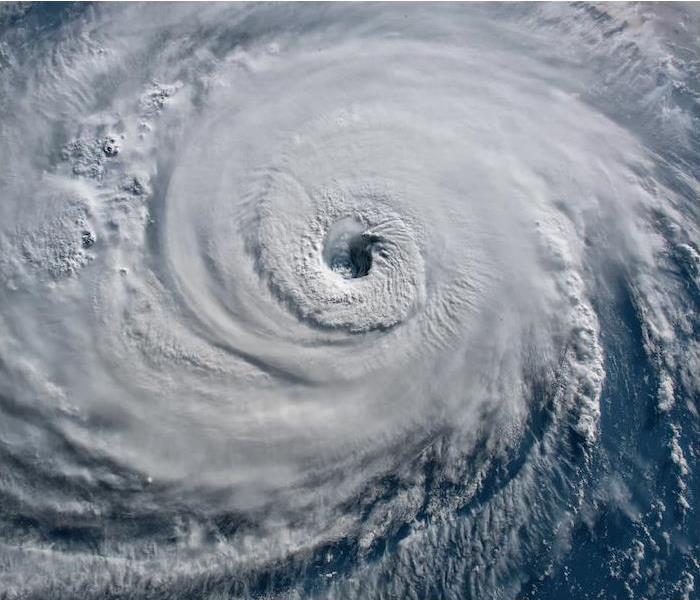 The impact of a hurricane is a serious event. SERVPRO of East Mecklenburg/Matthews are here to help with any cleanup and restoration.
The impact of a hurricane is a serious event. SERVPRO of East Mecklenburg/Matthews are here to help with any cleanup and restoration.
Hurricanes are damaging in myriad ways. A storm of that size can dump 10 to 15 inches of rain in the area it impacts, causing devastating water damage to a swath of soaked business and homes in its wake.
We often see news coverage of physical damage, displaced families and sometimes sadly we even get reports of injuries and casualties. But when the news coverage ends, the reality of a future full of instability remains, and much of the lasting damage from a massive weather event is felt in the area of financial recovery from water damage.
Water Damage and Its Financial Impact Locally
The frequency of extreme weather events is taking its toll on many areas and industries across the nation, and North Carolina is no exception.
In fact, North Carolina has suffered the damages of 20 different hurricane disasters in the last 30 years with a financial impact that has amounted to at least a billion dollars each.
The greater Charlotte and Mecklenburg area alone has felt the effects of officially recorded hurricanes or tropical storms an average of every six years over the last century, with the latest as of this writing being 2020’s Tropical Depression Bertha, with a windspeed of almost 30 miles per hour and a diameter nearing 35 miles.
Financial Impact of Hurricane Water Damage Nationally
In 2018 and 2019, there were 28 climate and weather disasters with financial losses exceeding $1 billion (among them Hurricane Florence in North Carolina). This falls in line with the average from 2015–2019, which is 13.8 disasters of this same type and minimum impact annually, with an incredible $136 billion in damages.
Hurricanes alone accounted for over half a trillion dollars in damages between 1986 and 2015. Being a coastal state puts North Carolina in harm’s path often, relative to other states, so it’s imperative to take each hurricane season with the utmost care, and do what you can to maximize preparedness, in order to minimize financial, structural and personal losses.
Add to the financial losses the fact that floodwater carries waste and pesticides which can cause illness, and that it promotes the growth of mold and mildew, and you’ve got an incredible amount of risk from water damage in such massive storms.
If your home or business should sustain water damage from storms or floods, SERVPRO has local technicians on standby 24 hours a day for emergencies, and we’ll be on hand to make sure your restoration needs are taken care of. Click or call today to be find out how we can help when disaster strikes.
Should I Be Concerned With Severe Weather? | SERVPRO® of East Mecklenburg/Matthews
2/18/2021 (Permalink)
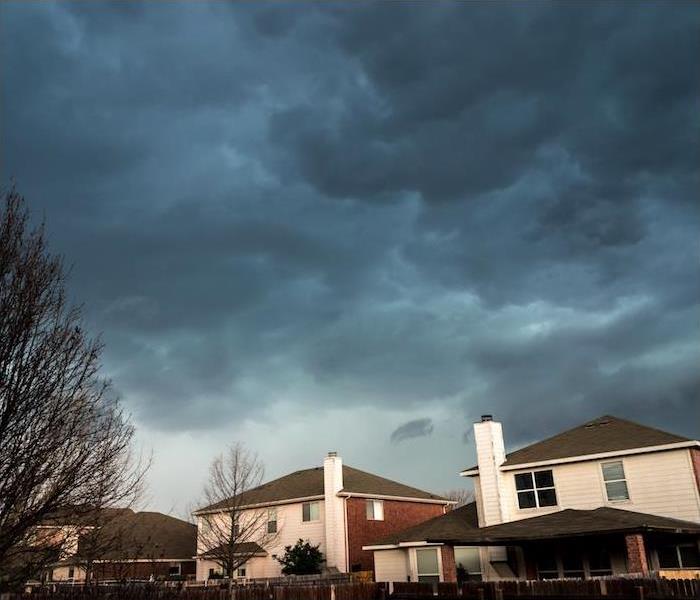 If your home is damaged due to a storm, SERVPRO of East Mecklenburg/Matthews is here to help. We will get the job done right, contact us today.
If your home is damaged due to a storm, SERVPRO of East Mecklenburg/Matthews is here to help. We will get the job done right, contact us today.
There are plenty of things to be concerned with on a daily basis, and for many people, planning for severe weather ends up pushed to the sidelines. Though severe weather can feel like a more abstract concern than a literal one, it is still extremely dangerous.
Responsible for many injuries and fatalities each year, severe weather can cause serious issues—especially for those who have not taken the time to prepare.
Why Should I Be Concerned With Severe Weather?
Severe weather is certainly unpredictable, but it is also unavoidable. Chances are, you will be impacted by a thunderstorm, high winds or heavy rains at some point, and not acting with safety in mind can put you or your family in harm’s way.
Severe weather can cause many issues ranging from lightning strikes to wind damage to bodily harm, in addition to the significant threat that flash floods can cause. Though we may never be able to know exactly when and where severe weather will strike, preparing for it is the best thing we can do.
How Can I Be Safer in the Event of Severe Weather?
Get a reliable weather update system. If severe weather is possible, local officials will issue watches and warnings accordingly, and being able to tune into these alerts can potentially save a life. Instead of relying on a cell phone, get a battery or hand-powered weather radio so you can tune in even if cell reception becomes spotty due to storms.
Pack a household emergency kit. Having an emergency kit in the home is a must, as storms can knock out power and floods can knock out utility services. Your kit should have everything your family might need for a few days, including light sources, food, water and first-aid supplies.
Create an evacuation plan. In most instances, you will want to stay put in the event of severe weather—but if you are in the path of a flash flood, you will want to move to higher ground. Make sure you have an evacuation plan in case this happens, and practice it as a family beforehand so you can execute it smoothly if you are in danger.
If your home is damaged due to a storm or severe weather, we are here to help. You can contact us at any hour to learn more about our restoration services or to report damage to your own home. Call us today.
What to Do if a Thunderstorm Catches You Outside | SERVPRO® of East Mecklenburg/Matthews
10/2/2020 (Permalink)
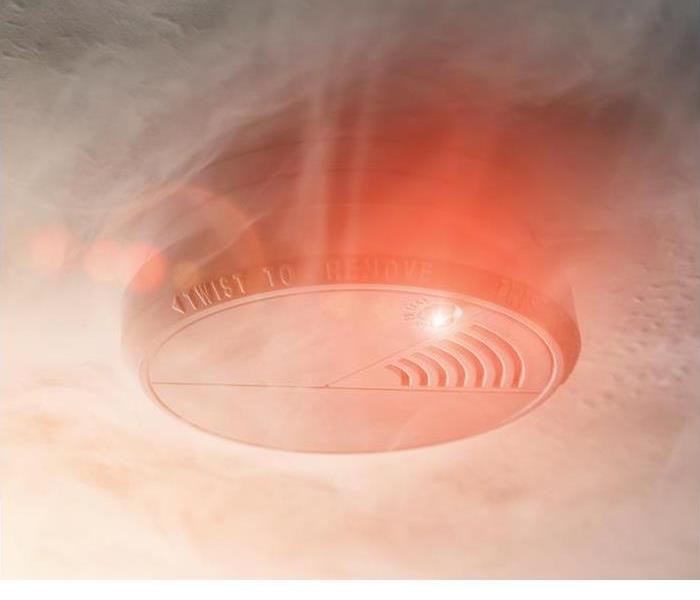 If your home is damaged by a storm, SERVPRO of East Mecklenburg/Matthews is available 24/7. We specialize in complete restoration services.
If your home is damaged by a storm, SERVPRO of East Mecklenburg/Matthews is available 24/7. We specialize in complete restoration services.
Thunderstorms can be frightening no matter where they occur, but if one catches you while you are outside and away from shelter, it can be absolutely terrifying to endure. While checking weather alerts is always a wise thing to do before heading out, storms tend to pop up suddenly this time of year as they thrive off of the heat and humidity of long summer days.
While being in a building during a thunderstorm is the safest option (with being in your vehicle a close second), if you are away from buildings and cars when a storm strikes, knowing what to do next is key.
How to Seek Shelter From a Storm if You Are Outdoors
Get to low ground. Lightning tends to take the most direct route to get to the ground, which is why it commonly strikes the tallest object in the vicinity. While this is not an absolute, the chances of being struck are certainly reduced if you are situated on low ground. Avoid hills or wide-open spaces, and try to crouch in a less exposed area if possible.
Avoid being near tall objects. Being extremely close to an object that is struck by lightning is almost as dangerous as being struck yourself, so avoid tall objects when possible. Trees, light poles, flagpoles and even fences are all more likely to attract lightning, so avoid them if possible to not be a target yourself.
Get away from water. Water is an excellent conductor of electricity, so if lightning strikes a body of water, everyone nearby is in danger. If you are swimming, get out of the water as soon as the first clap of thunder sounds, as that is a sign that lightning is nearby. If you are on a boat and can’t get to shore before the storm begins, put down your anchor and crouch down in the boat, or go into the cabin if your boat has one on board. Avoid touching any metallic surfaces in the boat, as well.
If your home or business is damaged by a storm, you can count on us to help. We are here 24⁄7 so you can report your damage and get a rapid response. Contact us today to learn more.
Storm Damage?
4/2/2020 (Permalink)
We always want to stay prepared and so to do that here is a list of facts and weather history to have us well suited for any upcoming weather.
- North Carolina averages 26 tornadoes, 3 tornado fatalities, and 39 tornado injuries each year.
- April is the peak month for tornadoes in the state. A secondary peak occurs in November.
- Tornadoes occur more frequently in the afternoon and early evening but can develop any time of day or night. The deadliest time for tornadoes can be at night since it is more difficult to be alerted of warnings that are issued.
- Severe storms don't have to produce tornadoes to be deadly. Straight-line wind gusts from severe storms can cause extensive damage similar to that of a tornado.
- In the last 5 years, 16 people have been killed and another 70 injured by straight-line winds from severe thunderstorms in North Carolina.
- A storm is classified as severe if it produces damaging winds or hail one inch in diameter or larger.
- In the last 5 years, baseball-sized has been reported 8 times in North Carolina. Golf ball size hail has been reported 200 times.
Make sure you have great shelter, which should be sturdy, small, and windowless at the lowest point of the building. A basement is a great example. If you don’t have a basement, a bathroom or hallway and even a closet will do just fine as well.
Stay informed and stay protected.
If your home or business suffers any damage from a storm, don’t hesitate to give us a call.
SERVPRO of East Mecklenburg / Matthews 704.847.8001
 Quick and efficient hurricane response from SERVPRO of East Mecklenburg/Matthews helps minimize damage and restore your property faster.
Quick and efficient hurricane response from SERVPRO of East Mecklenburg/Matthews helps minimize damage and restore your property faster.





 24/7 Emergency Service
24/7 Emergency Service











